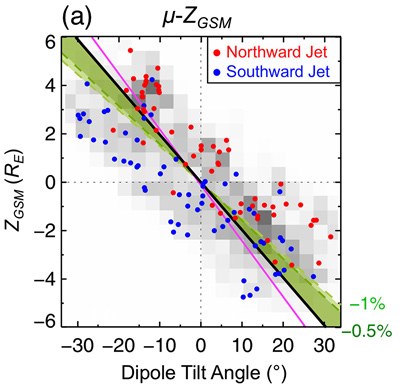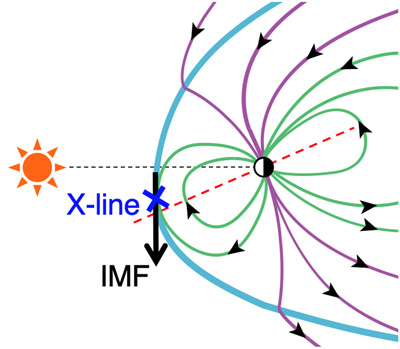
2018 THEMIS SCIENCE NUGGETS
Seasonal control of the reconnection line location on the Earth’s dayside magnetopause
by Yasuto Hoshi
University of Tokyo
Introduction
The Earth’s space environment is strongly influenced by solar wind energy coming from the Sun. The energy enters the near-Earth space mainly due to magnetic reconnection by which the Earth’s magnetic field and the interplanetary magnetic field (IMF) become interconnected on the dayside magnetopause. The location of magnetopause reconnection may change for different seasons and solar wind conditions. When the location of magnetic reconnection changes, the boundary conditions for magnetic reconnection can be changed. As a result, the efficiency of magnetopause reconnection can be changed, which may affect the amount of solar wind energy flowing into near-Earth space. For this reason, it is important in space weather modeling to clarify how the average location of magnetopause reconnection depends on the season and solar wind conditions.
It is known that magnetic reconnection can occur along a line extending from the magnetopause, called the X-line. Reconnected field lines accelerate plasma away from the X-line and along the magnetopause. This accelerated plasma flow is called a reconnection jet. The direction of the reconnection jet is northward on the northern side of an X-line, and similarly southward on the south side. Thus, on average, we can expect that the X-line exists between the distributions of the northward and southward jets. In this study, we identify the reconnection jets from 10 years of THEMIS spacecraft observations and estimate the average X-line locations on the magnetopause from the occurrence patterns of the reconnection jets for different seasons.
| Figure 1. Spatial distributions of the dayside reconnection jets and their velocities viewed from the Sun (projected onto the GSM y-z plane) for (a) −34° < μ ≤ −11° (the northern hemisphere is winter), (b) −11° < μ < 11° (equinox), and (c) 11° ≤ μ < 34° (the southern hemisphere is winter), where μ is the dipole tilt angle. The y and z directions are approximately in the directions of the dusk and north, respectively. RE denotes Earth’s radius, here defined to be 6,378 km. The red and blue bars represent the northward and southward jets, respectively. The lengths of these bars indicate the observed jet speed. The background gray shading shows the total time during which either of the THEMIS spacecraft was near the model locations of the magnetopause. |
Results
The 10-year observations (from June 2007 through November 2016) by the THEMIS spacecraft cover the entire season at the near-noon (10–14 magnetic local time) magnetopause. We identified a total of 711 reconnection jets from the THEMIS data. Out of a total of 711 events, 123 events were observed when the IMF was predominantly southward (nearly anti-parallel to the Earth’s northward magnetic field). The events are plotted in Figure 1 for each season. For quantitative analysis, we use the dipole tilt angle (μ) which is roughly equivalent to season. The dipole tilt arises from the inclination of the Earth’s magnetic dipole axis with respect to the Earth’s rotational axis and of the rotation axis with respect to the normal to the ecliptic plane. The magnetic pole tilts by up to μ = ±34° towards the Sun in the course of a year, where μ is positive when the North Magnetic Pole tilts towards the Sun.
| Figure 2. Dipole tilt angle dependence of the reconnection jet positions under the southward IMF. The red and blue points represent the northward and southward jets, respectively. The black line that best separates the northward and southward jet distributions indicates the north-south shift of the X-line. The green shaded area is the range of the statistical error of the black line. The background gray shading shows the total time during which either of the THEMIS spacecraft was near the model locations of the magnetopause. |
When the dipole tilt is small (Figure 1b; roughly corresponds to an equinox), the average north-south position of the X-line inferred from the jet distribution is near the subsolar point (ZGSM = 0) where the Sun is at the zenith. However, under larger dipole tilt (Figures 1a and 1c), the X-line tends to shift toward the winter hemisphere side (the northern hemisphere for −34° < μ ≤ −11° and the southern hemisphere for 11° ≤ μ < 34°). This result indicates that, under a tilted dipole, the dayside X-line location shifts away from the subsolar point toward the winter hemisphere during predominantly southward IMF conditions.
| Figure 3. Schematic drawing of the X-line location shift in the presence of a dipole tilt under predominantly southward IMF. The blue cross roughly represents the average location of the X-line as seen from the dusk side. |
Conclusion
Ten years of THEMIS observation at the dayside magnetopause allowed us to identify a total of 711 reconnection jets as direct evidence of magnetic reconnection. Among the jets, a total of 123 jets observed under predominantly southward IMF were used to estimate the X-line location. The directions and positions of the jets indicate that the dayside X-line location can shift from the subsolar point toward the winter hemisphere by about 6 Earth radii under the largest tilt of the geomagnetic dipole axis. Figure 3 schematically presents our statistical results of the average X-line location. The dipole tilt dependence of the X-line location implies that the boundary conditions for magnetopause reconnection could vary with season. This seasonal variation could possibly cause seasonal change in the amount of the solar wind energy flux flowing into the near-Earth space. This suggestion is compatible with ground observations showing that geomagnetic activity has a dipole tilt dependence.
Reference
Hoshi, Y., Hasegawa, H., Kitamura, N., Saito, Y., & Angelopoulos, V. (2018). Seasonal and solar wind control of the reconnection line location on the Earth’s dayside magnetopause. Journal of Geophysical Research: Space Physics, 123, 7498–7512. https://doi.org/10.1029/2018JA025305Biographical Note
Yasuto Hoshi is a Ph.D. student at the University of Tokyo, Japan. His research interests include transport of solar wind energy and plasma across the magnetopause.
 Please send comments/suggestions to
Emmanuel Masongsong / emasongsong @ igpp.ucla.edu
Please send comments/suggestions to
Emmanuel Masongsong / emasongsong @ igpp.ucla.edu



